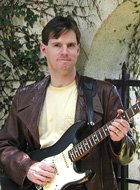Barrett,
Hey, buddy. I've just been working through your Chord-Tone Soloing book again and was wondering if you would indulge me and answer a couple of questions. These both have to do with the whole concept of hitting the closest available chord tone of the next chord. First of all, I have been trying to break out of my pentatonic rut by switching pentatonic scales with each chord. I thought of you because when I just switched scales without much thought as to what tone I "began" on, it sounded pretty rough; however, when I kind of focused on a neighboring note that was a chord tone of the next chord, things sounded much better. Question one is this: What if my phrases are kind of chord based, instead of linear/scalar and aren't really moving in a certain direction? In other words, if I am hitting a D over a D chord, but it's not really part of an ascending or descending line, and I move to an A chord, does it matter if I hit the C# or the E? Secondly, I am a HUGE fan of Neal Schon of Journey--I think his solos are the most beautiful and memorable, by far, out there. It seems to me that he solos entirely out of the tonic/parent diatonic scale, and I have spent the last year painstakingly trying to figure out how to solo with the entire major scale, without much luck. That's what brought me back to your book. I have had it in my head that you only hit the 4 note over the IV chord and can only hit the 7 over the V, etc.--heck, I've experimented with everything. Putting rhythm aside and only focusing on note choice, is there an easy insight you can give me into improvising with the major scale a la Neal Schon? I know that's a pretty wide-open question. Thanks again, Barrett, and keep up the great work.
Travis P.
Hi Travis,
For your first question: "if I am hitting a D over a D chord, but it's not really part of an ascending or descending line, and I move to an A chord, does it matter if I hit the C# or the E?"
Either the C# or the E will work on the A chord even if it is not part of a linear idea, though the linear approach to the chord tone reinforces your ability to hit it at the right time in a way that feels musical.
Beyond hitting the closest available tone of the next chord, you might next need to study melodic structure. Neal Schon's a good exemplifier of it.
Some quick examples are the little guitar melody in "Any Way You Want It" (around 2:00) and the longer one in "Who's Crying Now" (at 3:28).
These melodies are designed (not improvised, really) to fit a phrase of a specific length. A 'phrase' here is defined as a short chord progression, with a discernible beginning and end, that is usually repeated. In "Any Way You Want It" it's a four-bar phrase (G D/F# Em C). In "Who's Crying Now" it's eight bars (Am Am F F Dm G Am Am).
You can clearly hear the resolution point at the end of each phrase in the melody lines. The melody stops naturally in these places.
On "Any Way You Want It" the melody stops on the tonic G, which is the 5th of the IV chord at the time.
On the slow song he stops on the 9th of the Im chord at the end of the 8-bar phrase. There's a little breathing room before the same melody starts again. In the solo that follows, he keeps that phrase length in mind at all times, so he can finish up and return to the signature melody right on time for the fadeout.
Chord Tone Soloing sets you up for the skill by forcing you to count bars. In this case you have to count 4 or 8 bars while you're playing and do your best to finish off your licks at the beginning of bar 4 (or 8). With that in mind, it's ok if it goes past that point by a beat or two, but DO NOT let it hang over the end of bar 4 and into the next phrase. If it does hang over, it may feel like you're doing something really cool, but by about two bars later I can almost guarantee you're going to start feeling lost, and the melody will take on a random meandering quality that you don't want.
For practice you should start looking at chord progressions, writing them down and trying to identify the phrase lengths. If there is a I, IV, or V chord in bar 4 or 8, then it's probably there that you need your melody to resolve to a long chord tone, then take a breath and start it over. It can repeat exactly (and there's nothing wrong with planning it instead of improvising) or it can repeat with some variation.
Exaggerate that long note at the end. It should be longer than you think. A whole note in bar 4 is totally ok. Remember, there's a band playing with you, and they will fill up that space.
With time this kind of phrasing will develop as a reflex when improvising.
I better go now. Good luck and have fun.
Barrett

Tuesday, May 27, 2008
Subscribe to:
Posts (Atom)
Barrett Tagliarino
